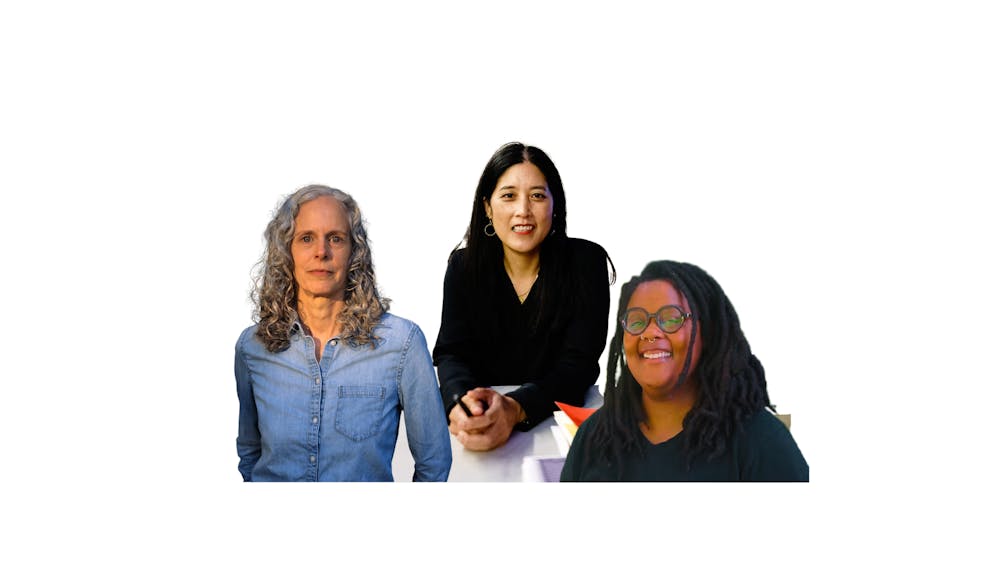
Choreographer Bebe Miller (center) visited Emory this weekend to help with the Emory Dance Company's reconstruction of her work,
"Prey." She also appeared at a Creativity Conversation on Friday afternoon, in conversation with Anna Leo (left) and Bridget Roosa (right). | Courtesy of Lori Teague
In the midst of a conversation with the Emory community last Friday, choreographer Bebe Miller stood up and threw her arms up in the air – waving them in a way that defied traditional technique and imitating a movement that she had once observed in a dance performance. She explained, "They just kind of were doing this. So I stole it."
Miller is just one of several distinguished guests who have been introduced to the Emory community through the Center for Creativity and Arts' Creativity Conversations. Emory students and faculty members are provided the opportunity to gain insight into many artistic processes through Creativity Conversations, which begins with a discussion guided by the respective department's faculty and concludes with an open question-and-answer session.
Creativity Conversation guests have all learned from borrowing from and sharing with other artists, a practice well-exemplified through Miller's simultaneously sarcastic and dead serious "so I stole it" remark. Friday's conversation opened as Emory Dance Professor Anna Leo introduced Miller, followed by Miller's own modest introduction of herself.
Leo, who previously danced with the Bebe Miller Company, spoke about Miller's four New York Dance Performance Awards ("Bessies") and multitude of grants and fellowships. She also reminded the audience that one of Miller's pieces, "Prey," is being reconstructed and set on a combined group of student dancers from Emory and Agnes Scott College this semester.
Meanwhile, while the audience finished applauding her many accomplishments, Miller humbly tapped into childhood memories of improvisation and early choreography exploration. Her favorite recollection pertaining to dance involved improvising while thinking of "clouds, trees and chocolate bars," a typical start to a professional dance career.
Miller is undoubtedly one for generous collaboration; she claimed during the Creativity Conversation that her choreographed pieces belong to her dancers as much as they belong to herself. Perhaps, she admits, this generosity is only due to her aging, but when asked if she prefers solo or group work, Bebe responded with the latter, because the environment allows for more valuable, shared observation – and "more jokes."
Miller has traveled near and far to work with the world's most unique, creative dancers. In 1999, she spent three weeks in northeastern Africa; struggling with disputes over the Ethiopian border, many people in the surrounding regions felt lost and leaderless. A small group of dancers from northeastern Africa, however, joined in on one of Miller's choreographic projects.
The dancers seemed altogether happy and grateful to be dancing in a supportive group environment, and as Miller noted, "they were all in a circle around me, doing what I was doing."
The floors in the African dance studio were made of marble, and the dancers' contemporary technique was limited. Nevertheless, Miller recalls that the dancers always carried positive attitudes. They always waited in a straight line shoulder-to-shoulder, suggesting that they all concurrently wanted to dance first when moving across the floor, and why not? As Miller asked, "Who wants to be second?"
Miller's experience in Africa has likely played a part in her inspiration for "Prey," the piece to be presented this November during the Emory Dance Company performance. The choreography of this reconstruction will be notated using Labanotation, a movement recording technique used to preserve choreography.
Miller and her notator Rochelle agreed that choreography can oftentimes become distorted when recorded on film or through other forms of modern media. Someone could easily trip in a performance that is recorded on video; when future generations watch the video in order to study the dance, they may assume that the original choreography called for a tombé (fall) and perform the dance as they had seen it.
Meanwhile, the fall was really an unintended dancer error and portrays inaccurately the original choreographic intentions. The utilization of Labanotation will thus make it possible for "Prey" choreography to be forever available in its original form, hopefully free of accidental falls.
Additionally this semester, in order for the Emory and Agnes Scott student dancers to truly convey Miller's original ideas, the dancers have been provided "Bebe Notes." Miller has her own company in Columbus, Ohio and therefore cannot spend the bulk of her time communicating her ideas directly to the "Prey" dancers. But these notes will prove useful in her place, as they not only bring Miller's motives into the rehearsal space but also help the dancers to discover their own individual purposes in the piece.
Although she is not currently in the midst of a new choreographic project, Miller has announced that she does have plans to start one. She announced at the Creativity Conversation that also in the near future she will be performing a solo of her own, choreographed by Leo.
Regardless of whether or not she is currently working on a project, Miller will share and steal for as long as possible. She plans to continue exploring human nature and to continue exploring through improvisation marked by "clouds, trees and chocolate bars."
–By Emily Sullivan
[gallery ids="12331,12332,12333"]





